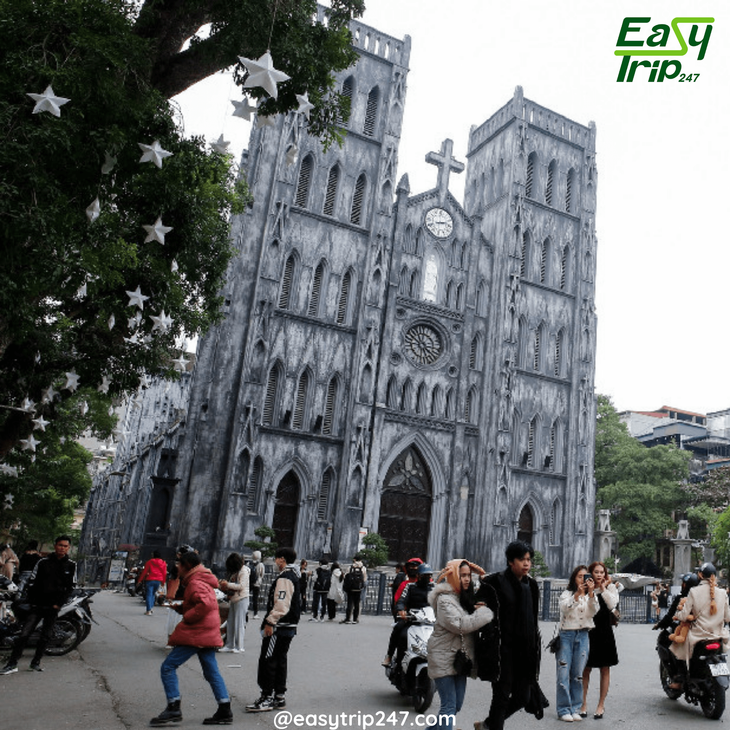
For architecture enthusiasts, a walking tour in Hanoi is an unforgettable journey through time, where every step reveals a new layer of the city's unique design influences, from ancient traditions to French colonial grandeur. Whether you’re an architecture student, a seasoned traveler, or simply someone who appreciates the beauty of design, a walking tour in Hanoi allows you to delve deep into the architectural wonders that make this city one of Southeast Asia’s most captivating. From the charming narrow streets of the Old Quarter to the impressive French colonial buildings and modernist structures that dot the landscape, Hanoi offers an architectural experience that is as diverse as it is stunning.
The walking tour in Hanoi for architecture enthusiasts begins with the Old Quarter, where the city’s roots are firmly planted in history. The Old Quarter is a labyrinth of narrow, bustling streets, each with its own distinctive character and traditional architecture. This area, with its iconic French and Vietnamese-influenced design, presents the perfect introduction to Hanoi’s architectural evolution. As you stroll along the winding streets during your walking tour in Hanoi, you’ll encounter colonial-era buildings with their characteristic shuttered windows, French balconies, and wide doors that open into hidden courtyards. The blend of Eastern and Western architectural styles in this area tells the story of Hanoi’s colonial past and the resilience of its people. A walking tour in Hanoi through the Old Quarter reveals how architecture can serve as a living testament to a city's complex history.
One of the highlights of the walking tour in Hanoi is the St. Joseph's Cathedral, a magnificent example of neo-Gothic architecture that stands proudly in the heart of the Old Quarter. Built by the French in the late 19th century, the cathedral's soaring spires and intricate stained-glass windows make it one of the most recognizable landmarks in the city. A visit to this cathedral on a walking tour in Hanoi offers a glimpse into the fusion of French Catholic architecture with traditional Vietnamese elements. The cathedral's grandeur stands in stark contrast to the bustling, chaotic streets surrounding it, making it a peaceful oasis for those interested in the intersection of culture, religion, and design. As you admire the cathedral's design during your walking tour in Hanoi, take a moment to reflect on the lasting influence of French colonialism on the city’s architectural fabric.
Beyond the Old Quarter, a walking tour in Hanoi also uncovers the impressive structures built during the French colonial period. One such building is the Hanoi Opera House, located on Trang Tien Street, an iconic French architectural masterpiece that rivals the grandeur of Paris' own opera houses. Built in the early 20th century, the Opera House's design is influenced by the French Beaux-Arts style, with its large columns, arched windows, and grand entrance that speaks to the wealth and power of the colonial era. During your walking tour in Hanoi, you’ll have the opportunity to admire the Opera House’s stunning façade and its intricate details, all while learning about its history as a symbol of both French imperialism and Vietnamese resistance.
As you continue your walking tour in Hanoi, you’ll also encounter a wealth of modernist architecture, reflecting the country's transformation throughout the 20th century. One of the most notable examples of this movement is the Presidential Palace and the Ho Chi Minh Mausoleum. Located in the Ba Dinh Square, this area is a key historical and architectural site, symbolizing Vietnam’s journey to independence. The Presidential Palace, with its bold and imposing design, represents the vision of modern Vietnam, while the nearby Ho Chi Minh Mausoleum, with its somber yet imposing structure, is an architectural tribute to the nation’s beloved leader. On your walking tour in Hanoi, you’ll discover how these modernist buildings contrast with the traditional wooden houses and colonial buildings around the city, offering a fascinating look at Hanoi's evolution from colonialism to independence. The combination of classical, colonial, and modernist styles found on this tour is a testament to Hanoi's dynamic architectural development.
No walking tour in Hanoi would be complete without a visit to Temple of Literature, one of the oldest and most iconic structures in the city. Originally built in 1070, this temple complex is dedicated to Confucius and is considered the first national university in Vietnam. As you walk through the expansive grounds, you’ll be transported back in time, surrounded by ancient architecture that is designed to embody Confucian principles of harmony and balance. The intricate carvings, ornate wooden beams, and meticulously manicured gardens all reflect the traditional Vietnamese approach to architecture. A walking tour in Hanoi through this cultural gem offers a rare opportunity to appreciate the beauty of ancient Vietnamese architecture and its role in shaping the country’s cultural and intellectual history.
While the historical and colonial architecture dominates the central districts of Hanoi, the city also has a growing number of contemporary and innovative buildings that add a modern flair to the cityscape. One such building is the Lotte Center Hanoi, a gleaming skyscraper that rises high above the skyline. As you walk around Hanoi’s more contemporary districts during your walking tour in Hanoi, you’ll notice how this sleek, glass-clad tower contrasts sharply with the traditional low-rise buildings found in the Old Quarter. The Lotte Center Hanoi represents Hanoi’s desire to embrace modernity while preserving its heritage, offering an intriguing juxtaposition of old and new. As an architecture enthusiast, you’ll appreciate how the city is gradually evolving, blending the traditional with the cutting-edge.
Throughout your walking tour in Hanoi, you’ll also come across an array of traditional Vietnamese homes and structures, such as the iconic tube houses. These narrow, multi-story buildings are a distinctive feature of Hanoi’s architectural landscape and are a response to the city’s population density and the limited space available. These homes, often no more than a few meters wide, are designed to make the most of vertical space, with each level serving a different function—living, cooking, sleeping, and entertaining. As you walk through the narrow alleys of Hanoi, you’ll encounter these unique structures, which are a reflection of the city’s ingenuity and adaptability. A walking tour in Hanoi offers an up-close look at these traditional homes, giving you a glimpse into the daily lives of the people who call this city home.
Another important stop on the walking tour in Hanoi for architecture lovers is the One Pillar Pagoda, one of the city’s most iconic landmarks. This Buddhist temple, built in 1049, is a stunning example of Vietnamese architecture, known for its unique design that consists of a small wooden structure perched atop a single stone pillar. The pagoda is not only a symbol of Hanoi’s architectural creativity but also an important religious site. The design, based on the lotus flower, is a representation of purity and spiritual growth, reflecting the Buddhist principles that underpin much of Vietnam’s cultural heritage. Visiting the One Pillar Pagoda during your walking tour in Hanoi offers an opportunity to witness firsthand the elegance and symbolism of Vietnamese architectural traditions.
In conclusion, a walking tour in Hanoi tailored for architecture enthusiasts is an exceptional way to explore the city’s rich and diverse architectural heritage. From the colonial elegance of the Hanoi Opera House to the ancient beauty of the Temple of Literature, Hanoi’s architecture tells the story of a city that has experienced centuries of change, blending its cultural traditions with modern influences. Every building, from the French colonial structures to the modern skyscrapers, contributes to the city’s unique charm and character. A walking tour in Hanoi allows you to appreciate these diverse architectural styles up close, giving you a deeper understanding of how the city’s past and present coexist in harmony. Whether you're admiring the intricate details of ancient temples, exploring the grandeur of colonial buildings, or marveling at the sleek lines of modern skyscrapers, Hanoi offers an architectural journey that is both captivating and inspiring. So, lace up your walking shoes, grab your camera, and embark on a walking tour in Hanoi that will leave you in awe of the city’s architectural beauty and its fascinating evolution through the ages.
Design Your Tour Today And Get A Quote. Contact Us Here: +84.975.504.825
Source: Easytrip247 Team compiled.
